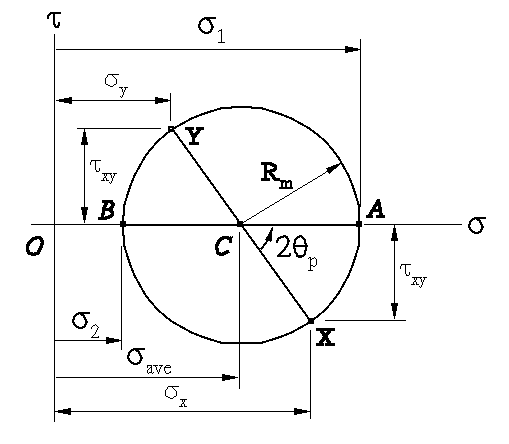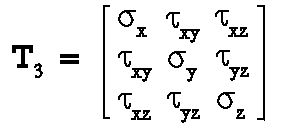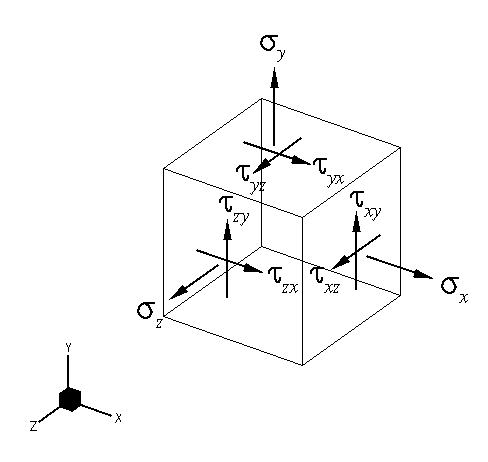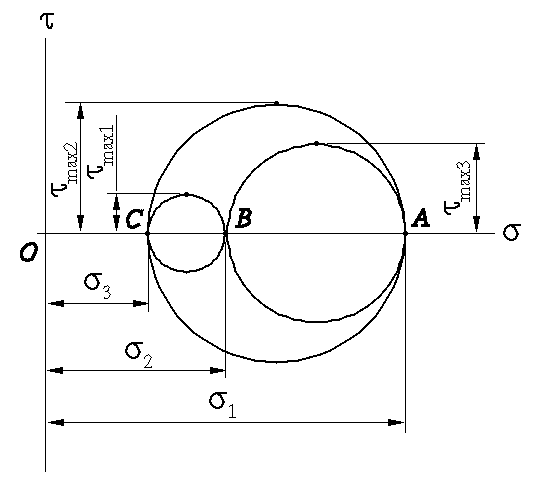How to Draw 3d Mohrs Circle
Mohr's Circle for 2-D Stress Assay
You can know about the theory of Mohr's circles from whatever text books of Mechanics of Materials. The following 2 are good references, for examples.
1. Ferdinand P. Beer and E. Russell Johnson, Jr, "Mechanics of Materials", Second Edition, McGraw-Hill, Inc, 1992.
2 . James M. Gere and Stephen P. Timoshenko, "Mechanics of Materials", Third Edition, PWS-KENT Publishing Company, Boston, 1990.
The 2-D stresses, so called plane stress problem, are commonly given by the three stress components southward ten , s y , and t xy , which consist in a 2-past-ii symmetric matrix (stress tensor):

(1)
What people usually are interested in more are the two prinicipal stresses s i and south ii , which are the two eigenvalues of the ii-by-2 symmetric matrix of Eqn (1), and the maximum shear stress t max , which can be calculated from due south 1 and s 2 . At present, see the Fig. one below, which represents that a state of aeroplane stress exists at point O and that it is divers by the stress components southward x , s y , and t xy associated with the left element in the Fig. ane. We suggest to determine the stress components southward x q , s y q , and t xy q associated with the right element after information technology has been rotated through an angle q about the z axis.
So, nosotros have the following human relationship:
(2)
and(3)
Equivalently, the above 2 equations can exist rewritten as follows:(4)
and(5)
The expression for the normal stress s y q may be obtained past replacing the q in the relation for south x q in Eqn. 3 past q + 90 o , information technology turns out to be(6)
From the relations for due south x q and south y q , 1 obtains the circle equation:(vii)
(eight)
This circumvolve is with radius R 2 thousand and centered at C = (s ave , 0) if let due south = southward x q and t = - t xy q as shown in Fig. 2 beneath - that is right the Mohr's Circumvolve for plane stress problem or ii-D stress problem!
(9)
which corresponds to the point at which q = 0 and the signal(ten)
which corresponds to the point at which q = q p that gives the main stress southward i ! Note that(11)
and the point(12)
which corresponds to the bespeak at which q = xc o and the indicate(13)
which corresponds to the point at which q = q p + 90 o that gives the primary stress south 2 ! To this terminate, one can pick the maxium normal stressess as(14)
Besides, finally one tin also read the maxium shear stress every bit(15)
which corresponds to the apex of the Mohr's circle at which q = q p + 45 o !Mohr's Circles for three-D Stress Analysis

(16)
What people normally are interested in more than are the iii prinicipal stresses due south 1 , south 2 , and s 3 , which are eigenvalues of the three-past-three symmetric matrix of Eqn (sixteen) , and the iii maximum shear stresses t max1 , t max2 , and t max3 , which can be calculated from due south 1 , southward ii , and s 3 .
Imagine that at that place is a airplane cut through the cube in Fig. 3 , and the unit normal vector north of the cut plane has the direction cosines five x , 5 y , and 5 z , that is
(17)
and so the normal stress on this aeroplane tin can be represented past(18)
At that place exist three sets of direction cosines, north 1 , n 2 , and n 3 - the three principal axes, which brand s n achieve extreme values s 1 , s 2 , and due south 3 - the three principal stresses, and on the respective cut planes, the shear stresses vanish! The problem of finding the principal stresses and their associated axes is equivalent to finding the eigenvalues and eigenvectors of the following problem:(xix)
The three eigenvalues of Eqn (nineteen) are the roots of the following characteristic polynomial equation:(twenty)
where(21)
(22)
(23)
In fact, the coefficients A, B, and C in Eqn (20) are invariants equally long every bit the stress state is prescribed(encounter e.g. Ref. 2) . Therefore, if the three roots of Eqn (20) are s i , s 2 , and s three , one has the post-obit equations:(24)
(25)
(26)
Numerically, i tin always find one of the three roots of Eqn (xx) , eastward.m. due south 1 , using line search algorithm, e.grand. bisection algorithm. Then combining Eqns (24)and (25), one obtains a simple quadratic equations and therefore obtains 2 other roots of Eqn (twenty), eastward.thousand. s two and due south iii . To this end, i tin re-order the three roots and obtains the 3 principal stresses, e.g.(27)
(28)
(29)
Now, substituting s 1 , due south ii , or southward 3 into Eqn (19), one tin can obtains the corresponding principal axes due north 1 , n 2 , or north 3 , respectively.Similar to Fig. iii, i can imagine a cube with their faces normal to n ane , n two , or n three . For example, 1 can do so in Fig. iii by replacing the axes X,Y, and Z with north ane , n ii , and n 3 , respectively, replacing the normal stresses due south x , s y , and due south z with the principal stresses s 1 , s 2 , and s 3 , respectively, and removing the shear stresses t xy , t yz , and t zx .
Now, pay attention the new cube with axes n 1 , north 2 , and due north iii . Let the cube be rotated almost the axis n 3 , and so the respective transformation of stress may exist analyzed by means of Mohr's circumvolve as if it were a transformation of plane stress. Indeed, the shear stresses excerted on the faces normal to the northward 3 centrality remain equal to zero, and the normal stress s iii is perpendicular to the airplane spanned past n one and due north 2 in which the transformation takes place and thus, does non affect this transformation. One may therefore use the circle of bore AB to determine the normal and shear stresses exerted on the faces of the cube as it is rotated nearly the n three axis (see Fig. four). Similarly, the circles of diameter BC and CA may be used to determine the stresses on the cube as it is rotated about the n 1 and n 2 axes, respectively.

Therefore, i can obtain the maxium/minimum normal and shear stresses from Mohr's circles for iii-D stress equally shown in Fig. 4!
Note the notations above (which may exist different from other references), one obtains that
(xxx)
(31)
(32)
Note that in Fig. 4, t max1 , t max2 , and t max3 are the maximum shear stresses obtained while the rotation is about northward 1 , n 2 , and n 3 , respectively.Mohr's Circles for Strain and for Moments and Products of Inertia
Mohr's circumvolve(south) can be used for strain analysis and for moments and products of inertia and other quantities as long every bit they can be represented past ii-by-two or three-by-three symmetric matrices (tensors).smithwhanderharty.blogspot.com
Source: https://www.engapplets.vt.edu/Mohr/java/nsfapplets/MohrCircles2-3D/Theory/theory.htm
0 Response to "How to Draw 3d Mohrs Circle"
Postar um comentário